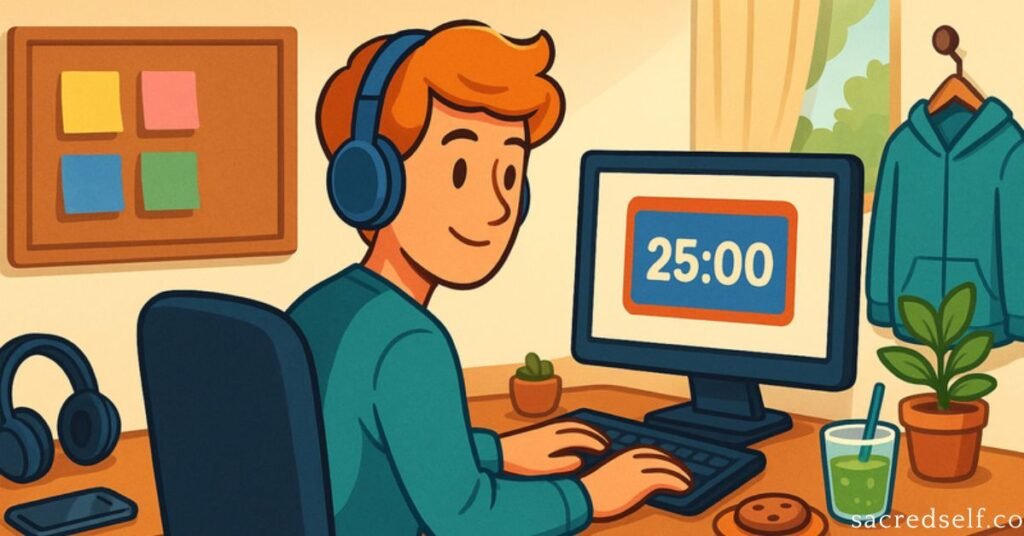If you’ve been feeling stuck, foggy, or unmotivated – you’re not alone. I’ve been through my fair share of mental slumps too, especially with ADHD in the mix.
I’m sharing what actually worked for me – from journaling and structured routines to running, clean eating, and even setting app limits to stop the scroll spiral.
In this guide, we’ll explore what causes a slump and also real, personal strategies that helped me reset that are backed by science as well.
Key Takeaways
-
Structure beats chaos – Simple routines and short to-do lists bring clarity and reduce overwhelm.
-
Movement resets your mind – Even 5-10 minutes of light exercise can lift brain fog and improve mood.
-
Cut the noise – Sugar and social media mess with your focus more than you think – dial them back.
-
Change your environment – A new workspace or even facing a window can completely shift your energy.
-
Tiny wins > huge goals – Small daily actions build lasting momentum. Think progress, not perfection.
-
ADHD or depression? Adapt wisely – Don’t just push harder. Journaling, movement, and mindfulness are better tools for rewiring the brain.
- 🧩 What Causes Mental Slumps
- 🚨 Symptoms of Mental Slumps
- 🔥 How to Get Out of a Slump and Get Motivated
- 🧠 How to Get Out of a Slump with ADHD
- 🏀 How to Get Out of a Mental Slump in Sports
- 🧰 Tools & Apps That Help You Break a Mental Slump
- 🧠 Mindset Shifts to Escape the Slump Spiral
- 🤝 When to Ask for Help (And Where to Go)
- ❓FAQs about Mental Slumps
🧩 What Causes Mental Slumps
Mental slumps don’t just show up out of nowhere – they build up over time.
Here’s what’s usually behind it:
- Poor sleep: A lack of quality sleep messes with your brain’s ability to reset.
- Overwhelm: Too much on your plate with no clear to-do list fries your focus.
- Emotional stress: Ongoing depression, anxiety, or burnout quietly wear you down.
- No change of pace: Staying in the same space kills momentum-changing scenery helps.
- Sedentary lifestyle: No movement = low energy. Even light activity can boost mood.
- Unrealistic expectations: Social media trains us to expect instant results. Real change takes time and consistency.
- Digital overload: Screens 24/7 leave your brain overstimulated and under-rested.
- Poor nutrition: Too much sugar or junk food messes with your energy and focus.
- Lack of sunlight: Less natural light = lower mood and messed up sleep.
- Isolation: Not talking to anyone for days? That loneliness builds quietly.
- Decision fatigue: Too many small choices can mentally exhaust you without you realizing it.
🚨 Symptoms of Mental Slumps
When you’re in it, it’s tough to see clearly – but recognizing the symptoms is the first step to getting out of a mental slump.
Here’s what to look out for:
- Low energy even after a full night of quality sleep
- Lack of motivation to start anything – not even small tasks
- Brain fog or trouble focusing for more than a few minutes
- Emotional numbness – you don’t feel excited or sad, just flat
- Avoidance of routines, people, or your to-do list
- Escaping into daydreams – You keep replaying old memories or imagining a better future, not to feel inspired, but to avoid the present. It feels comforting, but it also keeps you from acting.
- Irritability or short fuse – Small things feel overwhelming or frustrating.
- Indecision – Even basic choices (what to eat, where to start) feel impossible.
- No interest in joy – Hobbies, music, or even your favorite show just feel…meh.
- Inner guilt spiral – You feel bad for doing nothing, but also too tired to do anything.
- Avoiding self-care – Skipping meals, hygiene, or hydration becomes common.
- Numbing out – Binge-watching, scrolling endlessly, or snacking mindlessly just to escape.
These signs don’t mean you’re lazy or broken. They’re warning lights telling you your mental health needs care.
😵 Mental Slump: Cause vs. Fix Quick Table
| 😵 Common Cause | ✅ Reset Fix |
|---|---|
| Poor sleep or irregular routine | Go to bed and wake up at the same time daily. Avoid screens 1 hour before sleep. |
| Overwhelm from too many open loops | Use a 3-item to-do list. Prioritize small, winnable tasks. |
| Sedentary lifestyle | Move your body for 5–10 minutes. A walk or stretching is enough. |
| Overstimulation from social media | Use app limiters or put your phone in another room. |
| Blood sugar crashes from poor diet | Cut sugar early in the day. Start with fat, protein, and hydration. |
| Negative thought spirals | Journal one page. Get thoughts out of your head and into words. |
| No mental variety or stimulation | Change scenery. Work from a new spot. Try brown noise or nature sounds. |
| Lack of structure (especially with ADHD) | Stick to a basic routine. Visual tools like Trello or color-coded calendars help. |

🔥 How to Get Out of a Slump and Get Motivated
When you’re deep in it, motivation feels like a myth. But pushing harder isn’t always the answer – starting smaller is.
- Shrink the task: make your to – do list ridiculously simple (think: “drink water” or “reply to one email”) – for more on that check this summary of Atomic Habits from James Clear.
- Create momentum: use the 5 -minute rule: commit to just 5 minutes, then stop if you want
- Stack tiny wins – Every win builds confidence and momentum, even if it’s just clearing your desk, making your bed or doing 10 pushups.
- Change your space: sometimes a new coffee shop or walk outdoors (changing scenery) resets your focus
- Move your body: even a short walk helps boost mental health and clear brain fog, but a 1 mile run does the trick better for me personally – which is also proven to help with mental slumps
- Do the inner work – Meditation, yoga, journaling-these are game-changers. (I put together a full list of inner work practices).
- Read growth books – This one’s personal. I start my day reading for just 10–15 minutes. It gives me new insights (dopamine boost) and instantly checks off a win. It’s simple, and it works.
- Journaling: Writing things down makes your thoughts more real. Journaling might feel weird at first – but just try it. I don’t do it often enough, but when I do, it always helps clear my head.
To make things easier, adjust your environment:
- Declutter one small space daily – clear space = clear mind. Start with your desk, bed, or digital desktop
- Leave your running shoes by the door
- Place your book next to your bed
- Put the phone somewhere where it is hard to reach out, i.e in your closet in the other room
- Pair a boring task with some good music
- Set daily alarms for meditation, exercise
- Pre-pack your workout clothes
- Keep your phone on grayscale mode
- Use scent triggers – studies found that certain scents such as lavander decreases depression and stress. Personally, I use peppermint oil most of the time.
- Use “focus anchors”- Like a specific playlist, hoodie, or candle you only use when doing deep work. Your brain will associate that with flow.
Just like getting a mental slump happens silently over time – getting back your motivation doesn’t happen overnight.
Remember, 1 is bigger than 0 – small wins are 1000% better than no wins.

🧠 How to Get Out of a Slump with ADHD
If you’ve got ADHD, slumps are not just about low energy, it’s that you don’t even know where to begin. Motivation isn’t missing – it’s scattered across 40 open tabs in your brain.
Dr. Ned Hallowell, a leading expert in ADHD, says it best:
“The ADHD brain is like a Ferrari engine with bicycle brakes.”
Dr. Ned Hallowell
Most of the already mentioned tactics and habits also apply to people with ADHD, but we can expand the list and make it focused on your ADHD brain that revolves around dopamine.
- Timers over willpower – Use the Pomodoro technique (25 min on, 5 min off). Short sprints help bypass overwhelm and give your ADHD brain a finish line.
Make it visual – Use sticky notes, color-coded planners, whiteboards, or Trello/Notion. Crossing something off = dopamine hit. - Switch the scenery – Don’t work from the same spot every day. New environments = new stimulation. Even brown noise or lo-fi beats can refresh focus.
- Move First, Then Work: The NIH showed that physical activity directly helps regulate focus and mood in people with ADHD. I personally do Upa Yoga for 5-10 minutes. It’s the highest “ROI” exercise – very little effort with a big energy boost.
- Shrink the task, not your goals – Break everything into micro steps like “Open Google Docs” or “Write 1 sentence.” Helps avoid overwhelm.
- Reward small wins – After finishing a task, give yourself a dopamine reward: a quick walk, snack, game, or song you love.
- Try body doubling – Work next to someone, even virtually. Just having someone present improves focus and follow-through.
- Use sound intentionally – Brown noise, lo-fi, or ambient music can calm mental noise. Avoid overstimulating podcasts or lyrical music while focusing.
- Stack habits – Anchor new habits onto things you already do (e.g., journal after brushing teeth, stretch before coffee).
- Gamify your tasks – Use Habitica or a whiteboard tracker to “level up” daily habits. Treat routines like quests with mini-rewards.
- Avoid dopamine traps – Be aware of fake wins like endless scrolling, overplanning, or YouTube loops. They feel productive but leave you drained.
For more on small tasks check out Dr. Hallowell’s insights on small tasks and ADHD.
🎯 Tiny Dopamine Wins for ADHD Quick Table
| 🤏 Tiny Action | 💥 Dopamine Benefit |
|---|---|
| Make your bed | Instant visual win, signals order and control |
| Drink water with ACV + salt first thing | Hydration + routine = clear brain signal |
| Write 1 thing you’re grateful for | Shifts your brain into a positive loop |
| Cross off 1 task on your list | Small progress triggers motivation loop |
| Take a 5-minute walk | Boosts focus and mood, resets overstimulation |
| Journal one messy thought | Clears mental clutter, feels like a brain dump |
| Listen to brown noise or lo-fi beats | Calms your nervous system, reduces distractions |
| Read 1 page of a growth book | Instant learning = satisfying dopamine hit |
🏀 How to Get Out of a Mental Slump in Sports
Slumps don’t just happen in school or work – they hit hard in sports too. One day you’re locked in, and the next, every rep feels heavy, your mind’s foggy, and you’re wondering what happened to your fire.
You’re not weak. You’re not lazy. You’re likely burned out, overstimulated, or stuck in perfectionist mode – and it’s more common than you think.
- Change the stimulus – Try a new workout, drill, or playlist. Changing things up helps reset your focus without losing momentum.
- Pull back, don’t push harder – Slumps often mean you need rest, not more grind. Lower intensity or volume for a few days.
- Refocus on micro wins – Set tiny goals like “nail the warm-up” or “get one form cue right.” Small wins rebuild confidence fast.
- Talk it out – Even a quick chat with a coach, friend, or teammate can shift your mindset.
Athletes often confuse slumps with failure. But sometimes your brain just needs space to catch up with your body. Rest isn’t weakness – it’s strategy.
Real performance comes from knowing when to push – and when to reset.
For more on mental slumps and performance slumps in sports, I recommend Dr. Eli Straw video Tips to Get Out of a Performance Slump.
🧰 Tools & Apps That Help You Break a Mental Slump
Now that we know what’s behind a mental slump, and how to overcome it, it’s time to get into the tools and practices to make it easier for you to get back on track.
We don’t need 20 apps – just the ones that actually help.
✍️ Journaling Apps
Apps like Day One and Reflectly are great if you want a guided, structured way to brain-dump your thoughts.
That said, I personally prefer good old pen and paper.
There’s something about writing by hand that clears my head better. I use The One – Minute Gratitude Journal – it’s simple, quick, and helps declutter the ADHD noise.
⏳ App Limiters
If social media is your personal kryptonite (like it became for me), app limiters can be a life saver.
I use the Digital Wellbeing tools on Android to set strict screen time caps. It doesn’t always stop the scroll, but it interrupts it and reminds me that I got better stuff to do than watch funny cats videos on social media.
🧘♂️ Guided Meditation & Mental Health Support
Apps like Headspace, Calm, and BetterHelp are super popular – and for good reason. They help you reset when your brain just won’t stop spinning.
But what I personally use is Miracle of Mind by Sadhguru. It’s minimal, clear, and doesn’t overcomplicate things.
That straightforward style works really well for my ADHD brain – no fluff, just focus.

✅ What To DO (Your Brain Loves These)
- Hydrate first thing: Water + sea salt + ACV + turmeric + black pepper = energy boost
- Move your body: 5–10 mins of walking, stretching, or Upa Yoga before doing anything else
- Start with a win: Journal 3 things you’re grateful for → natural dopamine, puts things in perspective
- Protect the first hour: Do something productive or intentional before checking your phone
- Write a 3-task to-do list: Keep it simple: small, clear tasks like “open laptop” or “drink water”
- Eat stabilizing foods: Protein + fat > sugar bombs; Think: eggs, avocado, not cereal or pastries
- Change your scenery: Work near a window, go outside, or move to a new room
- Read something uplifting: 10 minutes of a growth book or inspirational content feeds your mind with clarity
🚫 What To Avoid (These Make Slumps Worse)
- Don’t check your phone first thing: Kills your momentum and hijacks your focus before the day begins
- Don’t start your day with sugar: Feels good for 10 minutes → crashes your energy and brainpower
- Avoid multitasking: ADHD brains thrive on focus, not chaos-do one thing at a time
- Don’t overcommit: Overwhelm = shutdown; Big plans feel productive but usually backfire in a slump
- Avoid clutter: Visual noise becomes mental noise-clean space = clean mind
- Don’t stay in the same spot all day: Same environment = same thoughts; Change your physical space to change your headspace
- Stop expecting motivation first: Motivation comes after action-not before
- Avoid numbing habits: Doomscrolling, random YouTube, endless podcast hopping = zero output and a foggy brain
🧩 Daily Reset: What To Do vs. What To Avoid
| ✅ What To Do | 🚫 What To Avoid |
|---|---|
| Hydrate with ACV, salt, turmeric, and water | Drinking coffee or sugar first thing |
| Start with movement (stretch, walk, Upa Yoga) | Sitting in bed scrolling your phone |
| Write a 3-task simple to-do list | Overplanning or creating massive task lists |
| Journal 3 things you’re grateful for | Ignoring your thoughts and bottling emotions |
| Work for 1 hour before checking phone | Opening social media right after waking up |
| Eat clean—protein and fats to start the day | Consuming carbs or sugary breakfast foods |
| Change your environment or work setting | Staying in one spot all day (especially the couch) |
🧠 Mindset Shifts to Escape the Slump Spiral
You can run 5km, eat clean, and journal all you want-but if your thoughts are dragging you down, you’ll stay stuck.
These shifts helped me stop spiraling and start moving again-especially with ADHD.
- Done is Better Than Perfect: Perfection paralyzes progress. I let myself be “perfect” in my photography – but in real life, half done > not started.
- Action Creates Motivation: You won’t feel like doing the thing-do it anyway for 10 minutes. Many times, that’s all it takes to gain momentum. Motivation follows action-not the other way around.
- One is Greater Than Zero: Start with anything small – make your bed, drink water, open the tab. Tiny wins = dopamine = movement.
- You Can Reset Anytime: You can reset your day at 2PM, 5PM-even right before bed. You’re never too late to restart.
- Structure = Freedom (for ADHD brains): Routines remove decision fatigue. Fewer choices = less overwhelm = more focus.
- Not Every Task Needs Your Best Self: You don’t need to be “in the zone” to take action. Low-energy effort still counts. Just showing up is enough.
- Feelings Aren’t Facts: Feeling lazy doesn’t mean you are. Your brain might just be tired, not broken. Treat emotions as data, not definitions.
- Progress Isn’t Always Visible: Sometimes progress is rest. Sometimes it’s choosing water over soda. Trust the invisible steps – they add up.
- Use Friction to Block Bad Habits: Make what’s helpful easy-and what’s harmful hard to do – Put your phone in another room – Use screen blockers.
- Stimulation Isn’t the Same as Support: Social media feels like rest – but overstimulates dopamine and drains you. Silence, a walk, or journaling gives your brain real recovery.
✅ Mindset Shifts: Old vs. New Thinking Quick Table
| 🧠 Old Thinking | ⚡ New Mindset Shift |
|---|---|
| I need to be motivated first. | Start small—action creates motivation. |
| If I can’t do it perfectly, I shouldn’t do it. | Done is better than perfect. |
| I messed up the morning, the day is ruined. | I can reset at any time—even 2PM. |
| I should always give 100%. | Low-energy effort still counts—just show up. |
| If I’m not productive, I’m failing. | Rest and slowness are part of progress. |
| My emotions define me. | Feelings are signals—not facts. |
| Structure feels restrictive. | Structure = freedom (especially with ADHD). |
| Social media helps me relax. | It overstimulates me—real recovery is quiet. |
🤝 When to Ask for Help (And Where to Go)
This one took me a while to accept. I’m old school – I don’t feel comfortable asking for help. I tend to keep things in and try to figure it all out myself.
But I do spend a lot of time researching. That’s how I stumbled into things like meditation, journaling, my morning hydration mix, and how diet impacts your mood and mental clarity.
Still, some slumps aren’t just a mindset or lifestyle thing. Sometimes you need support.
And knowing that you need support is not a weakness – it’s smart. It gets you out of a mental slump lot faster and you become more productive.
When It’s Time to Reach Out
- You’ve been stuck for weeks
- You feel numb or hopeless
- You’re avoiding everything, even basic tasks
- You’re self – isolating or using sugar, screens, or substances to cope
- Sleep is totally out of sync
Where You Can Go
- Therapists – even just once to get a direction
- BetterHelp – online therapy if in – person feels too much
- Mental health apps – Calm, Headspace, or Miracle of Mind by Sadhguru (simple and grounding)
People you trust – a friend, a partner, someone who listens without fixing
❓FAQs about Mental Slumps
How long do mental slumps last?
There’s no fixed timeline. A mental slump might last a few days, or drag on for weeks if we ignore the warning signs. But the sooner you start doing small, consistent resets, the faster you pull yourself out.
How do you get out of a slump of depression?
You don’t climb out in one leap – you build your way out with small steps. For me, it started with running, journaling, cutting sugar, and finally creating routines that gave my mind less room to spiral.
And sometimes, the most powerful move is reaching out for help.
How do you get out of a mental slump fast?
You reset the brain, not fight it. A walk, a glass of water with salt and ACV, and avoiding your phone for one hour does more than you think.
Another one I do that I did not mention is fasting – on the weekends try a 24 hour fast. It can work wonders mentally and physically. Especially if you mix it with meditation – check out my post here on the benefits of fasting and meditation.
It’s not about doing more – it’s about interrupting the loop.
How do you fix feeling mentally drained?
Most of the time, it’s not laziness – it’s overload. When your brain is juggling too much, it crashes.
Simplifying your inputs, moving your body, and sleeping better are the most underrated fixes.
What finally got you out of depression?
For me, it was structure. Running most days, journaling to declutter my mind, cutting out sugar and social media, and doing creative work like photography. None of it was instant – but all of it was worth it.
Why do I get mentally drained so easily?
Your brain might be working harder than you realize. ADHD, poor diet, low sleep, or overstimulation (like social media) fry your circuits. Simplify, slow down, and reset often – your energy will catch up.
How do I do a mental reset?
It’s like rebooting your system – shut the noise down and spark something clean. Move a little, journal one page, drink something nourishing, and do one small thing without distractions.
No overthinking. Just forward.
Final Thoughts: Getting Out of a Mental Slump Is Possible
We’ve covered a lot – because getting out of a mental slump isn’t a one-size-fits-all process.
Whether it’s caused by burnout, depression, ADHD, or just plain overwhelm, there are ways to get back on track.
The key is: don’t try to fix everything at once. Pick one thing. One small win. And start there.
For me, it’s all about maintenance. My default state feels drained and low-energy, so I need to stay consistent with the basics.
- A 10-minute run or some light yoga/stretching.
- Reading for 30 minutes.
- Journaling minimum one page.
- Also, 20 minutes naps can be very helpful in busy days – I use a video from Joe Dispenza to do that effectively.
- And limiting how much time I spend on social media.
If I don’t give myself at least 1.5 hours a day to maintain, I start slipping back into the slump.
So what’s your one small thing today? Drop a comment and let me know what’s helped you break out of a slump – or what you’re going to try first.
Namaste. 🙏
Articles on a Similar Topic
This post may contain affiliate links. As an Amazon Associate, and as an affiliate of other online retailers, we earn from qualifying purchases - this means that if you buy something through a link, we may earn a small commission at no extra cost to you.



